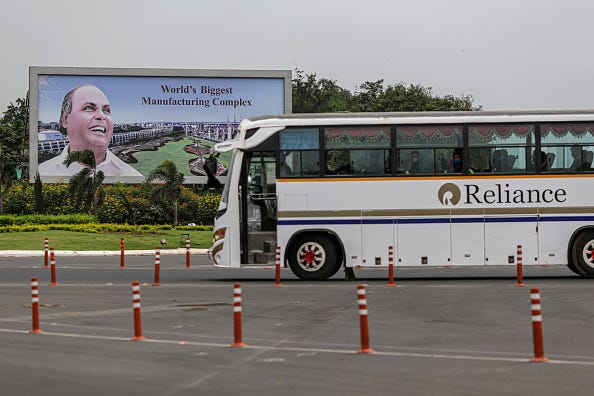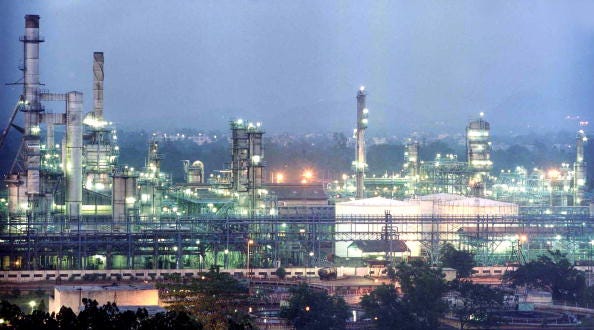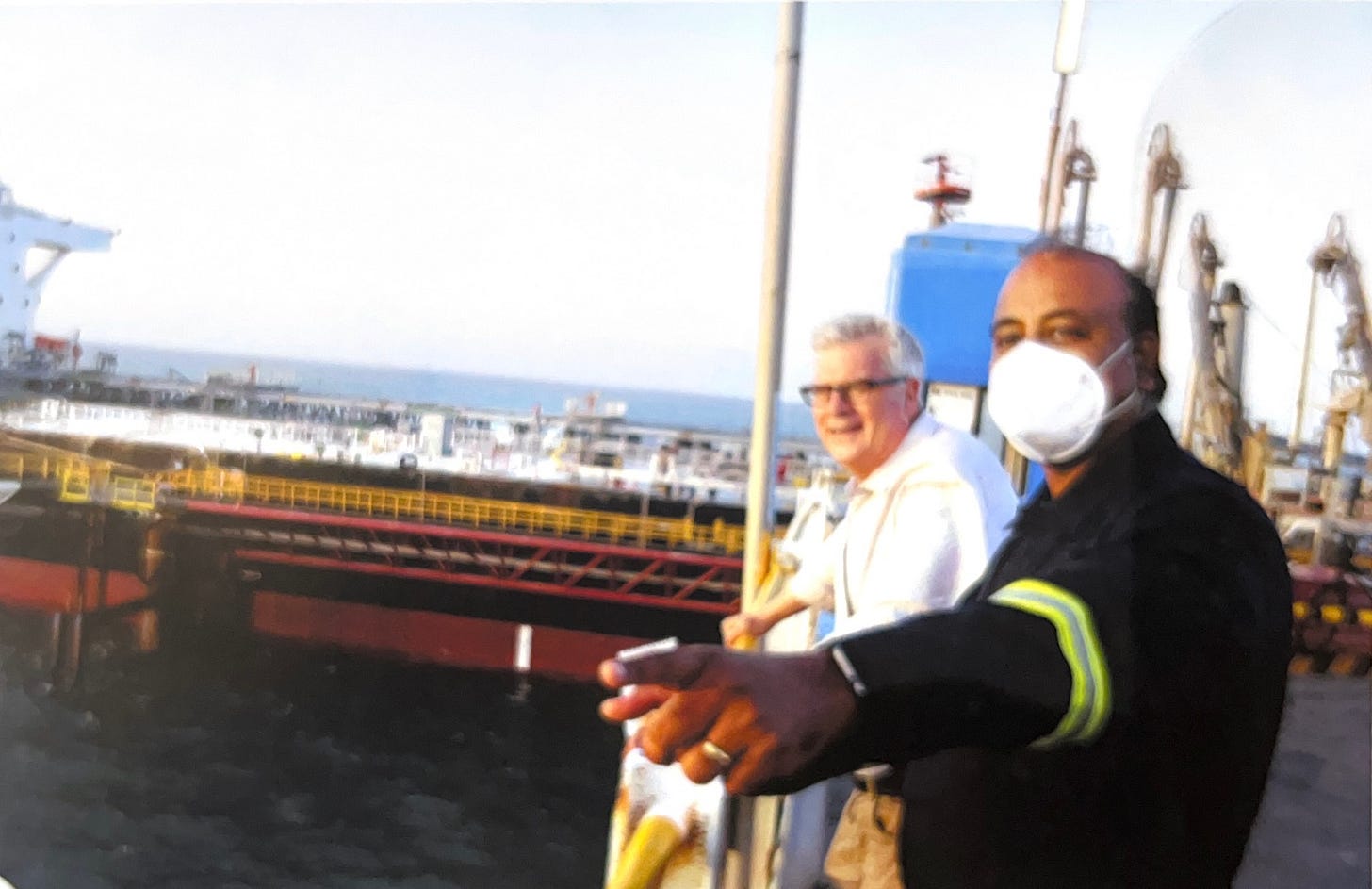At the World’s Largest Oil Refinery, the Energy Transition Gets Underway
Reliance Industries’ facility processes about 1.4% of all the oil produced in the world every day. Even here, the transition to renewable energy is gaining momentum.
Few places capture the promising yet perilous state of the world’s energy transition better than where I visited earlier this week: The world’s largest oil refinery, situated in a once-empty desert along the Gulf of Kutch on the Arabian Sea.
Here Reliance Industries Ltd. takes in 1.4 million barrels of crude each day from tanker ships offshore. The facility is a sprawling forest of pipes, tanks, boilers, generators and catalyzers, all landscaped very attractively with flower beds, greenery and ponds hosting geese and ducks and migratory birds.
It operates 24-7-365, turning oil into the full array of fossil fuel-based products the world demands. These include everything from gasoline, diesel and jet fuel to the petrochemicals used in plastic packaging and clothing. The facility grew in three rounds of rapid development between the late 1990s and the mid-2000s, transforming Reliance into a global energy titan and its leader, Mukesh Ambani, into one of the world’s wealthiest and most powerful magnates.
These days, in a previously unused corner of the complex, something else dramatic is getting underway. Another vast expanse of sandy soil has been flattened, just as the rest of the land once was. The foundations are being laid for the most ambitious integrated renewable energy project in the world.
Ambani, whose father founded Reliance and built it into an oil and gas giant, is building a huge solar panel factory here. That’s just for starters. This will be followed by a massive factory to produce batteries for storing renewable energy produced by the solar panels. Then will come another giant factory to make hydrogen electrolyzers, a carbon-free technology coming into view as a potential mainstay of the new energy age for making steel and fertilizers, as well as powering ships and perhaps someday even planes. Following the electrolyzer plant will come another factory that will manufacture fuel cells. These will deploy the hydrogen to power trucks and buses, perhaps cars. It’s an ambitious plan that starts with Reliance itself reaching net-zero carbon status by 2035 and builds from there to help India reach its national goals along the way to net zero by 2070. Ambani has vowed to pour $80 billion of investment into the project before the end of the decade, a scale and speed rivaling anything Reliance has done.
No doubt he’s serious. The Jamnagar refinery rose with stunning speed, defying skeptics and inculcating a determined corporate culture. Text scrolling around and around a complex of massive flashing screens in Jamnagar’s control rooms display words ascribed to Ambani’s father, Reliance founder Dhirubhai Ambani: “For those who dare to dream, there are worlds to win.” Senior managers routinely, without a trace of irony, say things like, “The word ‘impossible’ doesn’t exist here.” This corporate promotional video about the construction of the Jamnagar complex gives you a sense of how the company, and many employees, view their mission.
The Ambanis have also carefully aligned their ambitions with those of Prime Minister Narendra Modi, first during his stint as the chief minister of Gujarat and, since 2014, as he has solidified his position as India’s most significant leader since the country’s founding prime minister. The company’s success, flowing in no small part from its ability to secure regulatory approvals and maximize government policies to its advantage, has helped Modi as well.
Ambani has used the overall combination to plunge into new industries. He upended India’s telecommunications and media industries between 2016-2020, when I was living in India, with a new company called Jio. Moving at warp speed for a massive nationwide infrastructure project, Reliance Jio built a mobile phone network in just a few years that saturated cities and reached virtually every remote village. The company then used the network as a beachhead to push into media and retailing, challenging even Amazon in India.
The Modi government is focused on energy, particularly renewable energy and hydrogen. So is Reliance. One of the top Jio executives from that time is now heading the company’s renewable energy efforts. The company is just one of several oil and gas heavyweights in India that are joining the renewables binge, some of whom I’ve written about earlier and others I have yet to get to.
It is impossible to stand on the still quiet but soon-to-be-bustling new energy side of the Jamnagar complex, looking over at the hulking profile of the traditional refinery next door, and not think about the state of the global energy transition. Russia’s Ukraine invasion has shocked the world into a new awareness of how critical energy really is — and how precarious. When I covered the global energy beat for The Wall Street Journal, I used to say covering energy is a bit like covering air — few think about it until it’s in short supply — a lesson I first learned in New York’s citywide 2003 power outage and then, even more acutely, during visits to war-torn, and blackout plagued, Iraq after the U.S. invasion that year.
Where should we get our energy from, both now and in the future? The rapidly growing urgency of climate change tells us it must come from non-carbon sources, starting immediately. Soaring prices of oil, gas and coal tell us to hustle for more of any of those we can get into the system quickly to bring prices down.
In the breach, different parts of the world are responding to these intensifying pressures differently — each region standing more or less where it sits. In the U.S., the world’s biggest oil and gas producer, a push is on to produce still more oil and gas. Europe — dependent on imports for 60% of its energy, a good deal of it from Russia — lurches between clinging even to Russian oil and gas while trying to square that with a realization now is the moment to decarbonize its energy sources. Middle East petro-states revel in the world’s sudden seeming desperation for fossil fuels only months after so many urged their rapid phase out at a global climate conference last year. India and China, both importing a greater share of their energy even than Europe, are grabbing any immediate sources of fossil fuel they can find, from Russian crude to domestic coal.
As during the oil shocks of the 1970s, energy security is front of mind. The air is suddenly thin. The difference from a half century ago is that this time there are alternatives: solar, wind, hydrogen, increasingly cheap batteries and eventually fuel cells to knit it all together. Electric car sales doubled last year, and are expected to double again this year. Nuclear power appears on the cusp of a comeback, this time with smaller and safer reactors. Even cutting energy demand — the only option in the 1970s for reducing dependence on fossil fuels — is entering a new era where big data, computer algorithms, the connectivity of 5G networks and smart meters can squeeze out new efficiencies and benefits.
There are heat pumps! Good old fashioned turning down the thermostat in every gas-heated building in Europe by a single degree would save 6% of the amount of gas the E.U. imported from Russia last year, according to the International Energy Agency. The outright leakage and deliberate wastage of total gas supplies going into Europe is equal to about one-fifth of all the Russian gas imported by the E.U., the agency says. Reducing those would not only create more marketable gas but also substantially reduce emissions of methane, an incredibly potent greenhouse gas most nations and companies have already vowed to stop emitting.
The U.S. may ramp up some oil and gas production for now. Europe may delay some immediate decarbonization goals. Saudi Arabia may crow over a banner year for oil export revenues. China might burn more coal than ever this year.
Yet China also led the world in solar power last year, adding an amount almost equal to the total power capacity of Spain. It might add another third more again this year, alongside world-beating installations of offshore wind turbines. Reliance’s Jamnagar refinery is still operating at maximum capacity. Yet next door, on a field very soon to be no longer flat and empty, the future of clean energy production is gathering force.
It’s not likely to be thwarted. Countries focused on energy security, fast-growing Asia especially but also in Europe, won’t build their future on imports of volatile energy supplies. Not when there are choices, as increasingly there are.






